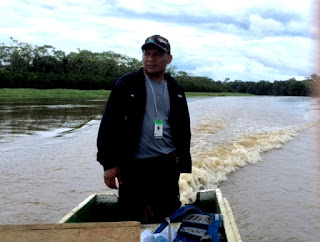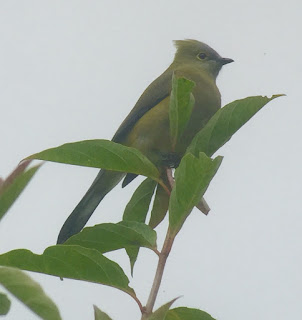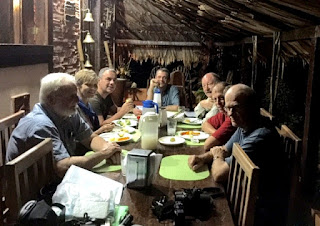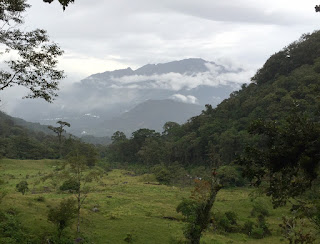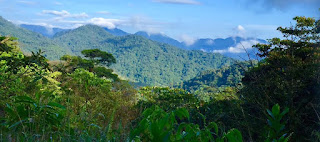![]() |
| The night parrot recently netted - Pic by Rachel Barr |
The following is the text of my news story and feature on the Night Parrot in the 29-30 August edition of The Weekend Australian.
NEWS STORY
Grooming traps to secure site for rare birds
Newly designed traps that kill feral cats with a poisonous spray will be operating soon at a site in south-west Queensland that is home to the only known population of the critically endangered night parrot.
Sharp-shooters were deployed on the remote property this week and soft jaw traps were set in a concerted bid to eradicate several feral cats that are prowling the area.
The menace of feral cats has emerged as the biggest threat to the survival of the population, with as few as 10 birds at the site on a grazing property south-west of Winton.
The “grooming” traps to be set soon are able to detect and identify cats that pass within five metres, triggering a spray of deadly gel which is ingested when the animal grooms by licking its fur.
The Australian revealed earlier this month new photographs and video footage of a night parrot taken by research scientist Steve Murphy on the property. Bush Heritage Australia is in the process of acquiring 56,000ha of the land so it can be protected as a reserve.
The night parrot was once widespread throughout inland Australia but has disappeared from many places where it was common.
Dr Murphy believes the south-west Queensland population has survived because the rocky terrain has kept wildfires in check. His unpublished research reveals that large, old-growth spinifix patches are the favoured habitat of the mysterious parrot.
Dr Murphy said relatively few feral cats, which were voracious predators of night parrots elsewhere in the past, had been detected at the site. He believes this is because they find it difficult to hunt in areas where the predominant vegetation is prickly, unburnt spinifex – a habitat that was once widespread but is now scarce because of the increasing incidence of fire since European settlement.
“It seems that the parrots may be able to find safe refuge to some extent in this old spinifex,” he said.
However, a single cat could learn how to hunt night parrots and potentially wipe the population out. Bush Heritage Australia north chief executive Rob Murphy said cats were “top of our hit list” of management priorities.
Mr Murphy said the grooming traps, being developed in partnership with South Australian company Ecological Horizons, had promising potential to control cat numbers.
“This is exciting new technology and we hope it will help us to eradicate cats in the parrot's core habitat,” Mr Murphy said.
The night parrot, one of the world's rarest birds, had been known from a handful of records over the past century before it was photographed on the property by north Queensland naturalist John Young in 2013 following a six-year search.
Mr Young, whose discovery made news internationally, had been working with Dr Murphy and Bush Heritage Australia on night parrot management and research at the site but ended his involvement several months ago.
Mr Young has taken to social media to distance himself from the project.
“The whole thing has been very hard for me and every day I begin to wonder whether the heartache, cost and all the effort was worthwhile,” Mr Young said on his Facebook page, without explaining his reasons.
“In the last few years my work has been a living hell and enough is enough now... It has been a long and tumultuous road with all sorts of stuff but I hope I have left something for the world of conservation.”
Dr Murphy acknowledged Mr Young's role in the night parrot's rediscovery.
“John has my complete respect for the skill he demonstrated in finding the bird; for hisopenness insharing the experience with me; and for thematurity he displayedin letting Bush Heritage and others get on with the job,”Dr Murphy said.
![]() |
| The Night Parrot before release. Pic by Rachel Barr |
FEATURE
When a bird in the hand is really rare
It was music to his ears. The high-pitched, melodic, haunting call of the night parrot. When research scientist Steve Murphy analysed the data from audio recorders he had in place across an arid hillside at a secret location in south-west Queensland, he realised that no fewer than four night parrots were calling at the same time.
Four night parrots. That was the equivalent of the total number of human encounters with this most enigmatic of birds over the previous 100 years. Murphy's work on the night parrot is emerging as one of the most exciting developments in Australian natural history research in recent decades.
The curtain is being raised slowly on the ecology and habits of the Holy Grail of Australia's birding world since Murphy and Bush Heritage Australia revealed earlier this month that plans were advanced to secure a 56,000ha reserve over the only site in the world where the parrot is known from. At the time, Murphy released to The Australian photographs and video footage of a netted night parrot.
How has the night parrot survived in this harsh landscape of gibber plain, rocky outcrops and spinifex in Queensland's channel country, south-west of Winton, when it has disappeared from the vast tract of inland Australia it once inhabited? This weekend, Murphy is heading interstate, to South Australia, to see if he can find more parrots.
It was in north-east South Australia that the first specimen of the night parrot was collected, in 1845 during the failed expedition led by Charles Sturt to find Australia's mythical inland sea. And it was in South Australia, in the 1870s and 1880s, that 16 of the 23 known specimens of the bird were collected. The last living specimen was collected in Western Australia in 1912.
Then nothing more but a couple of brief sightings until a dead night parrot was found in 1990, with a second dead bird picked up in 2006. Both were in the same general region of south-west Queensland where bushman John Young heard one calling in 2008. Then, in 2013, after years of effort to track them down, Young revealed the first photographs taken of a night parrot, at the site now being studied by Murphy.
Murphy believes the parrots have hung on at this site because of the terrain, habitat and paucity of introduced predators. His research has established that the birds favour large, old-growth clumps of spinifex. Each bird has its own roost, buried deep within a spinifex clump. The birds leave the roosts soon after sunset, travelling up to 7km during the night to feed.
From sound recordings, Murphy has established that parrots favour certain areas for roosting and other areas for feeding. “We were able to get an idea of where the birds were moving to,” Murphy says. “There was some predictability about their movements and habits.”
In two years of research, Murphy has seen a total of three parrots, including the one he netted and photographed with his partner, Rachel Barr; this bird was seen twice subsequently, including once when it flushed from its daytime roost, which contained a single feather. “This is a bird that is extremely cryptic,” Murphy says.
![]() |
| Old-growth spinifex north-east of the Night Parrot site |
Most of the parrots are within a 10km radius of John Young's discovery. Murphy now backs away from his earlier estimate of the population at between 10 and 30 birds. “It is impossible to say how many parrots there are,” he concedes. He heard a night parrot 40km from the site, suggesting that a second population may be present in the region. Whatever the number, the known world population is miniscule.
The parrot that was netted was unexpected. Murphy and Barr were at opposite ends of a long mist net soon after sunset during the April Easter weekend when it flew randomly into Barr's end of the net. Netting during the previous three evenings was unproductive.
The old-growth spinifex at the site was formerly widespread in other areas previously frequented by the parrot. As long ago as 1925, the collector Lawson Whitlock searched in vain for a year for the species in one such area west of Alice Springs, where Aborigines had tracked down “porcupine parrots” and cooked them on camp fires. Whitlock described his search as the “most arduous I have undertaken”.
It is likely that by Whitlock's time, the landscape of central Australia was undergoing fundamental change that had dire implications for the night parrot and other arid zone wildlife. Traditional Aborigines had for centuries conducted patchwork burn-offs for various purposes, but the practice ceased with the development of the grazing industry and European settlement.
![]() |
| Researchers at the Night Parrot site: Pic by Bush Heritage Australia |
Instead,wildfires of unprecedented intensity ravaged vast areas intermittently. The original habitat has gone and is denied the opportunity to return.The same problem is evident inthe savannah woodlands of tropical Australia. The carpentarian grasswren, a small bird,was once numerous in the sandstone screeswest of Borroloola in the Northern Territory; as a result of wildfire, the grasswren has vanished.
The Queensland region frequented bynight parrots is home to other wildlife in decline elsewhere. The endangered bilby is present; so too isthe biggest population of bush stone-curlews in outback Queensland. Murphy believes the survival of the animals is linked to fire control and a dearth of feral predators. The landscape is markedlybroken compared to many inland areas;unburnt spinifex clumps are separated by barerocky areas which maykeep the spread of fire in check.
Low level grazing on the property appears to have had no adverse impact on the parrots. Murphy has not seen a fox or a cat at the site, although five cats have been captured on the 30camera traps in place, which have failed to photograph a night parrot in 15,000 hours of operation. “I carry a gun with me whenever I go out but I've never seen a cat,” he says. “I've seen more night parrots than cats.”
Old-growth spinifex provides the parrots withseemingly effective refuge from predators, which are deterred by its prickly exterior.
![]() |
| Dingo at the Night Parrot site - Pic by Steve Murphy |
Murphy believes the presence of dingos in the area is an important factor in controlling cat numbers. The ownersof the 1 million-ha property where the parrots occur haveagreed not to cull dingoes as part of a management strategy being implemented.
CSIRO arid zone ecologist Chris Pavey agrees the presence of large, unburntspinifex patches could be keeping cat numbers in check and the key to the parrot's survival.“Mature spinifex allows animals to find refuge so it is likely to be harder for cats to hunt,” Pavey says. “Each cat would need a much larger home range than might be the case elsewhere. It's not too far from this site to where 200 to 300 cats were being shot each night not so long ago.”
With feral cats in plague proportions elsewhere,Murphy regards the felinesas the most seriousthreatto the parrots. Cat numbersare increasing across much of northern Australia – the population nationally is estimated at 20 million-with native wildlife populations crashing in recent years in many placesas a result. Earlier this week, before heading to South Australia, Murphy travelled to the parrot site with a team of sharp-shooters in search of cats and to set traps.
Murphy has amassed a substantial collection of night parrot calls on sound recorders.Playback of calls could provide an importantrole in detecting other night parrot populations; birds may reveal their presence by responding to random playback of their calls.
The recordingsare presently under wrapsbecause the secrecy of the site is paramount while effortsto secure it as a reserve are finalised. However, Murphy says theywill be made available to other researchers: “Nobody arguesabout the benefits of doing that and it will be done.”
When the recordings are distributed, efforts will be underway in earnest to find more night parrots, hopefullybefore this remarkablespecies succumbs to the twin scourgesof wildfire and feral cats.






